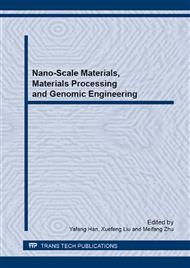p.95
p.100
p.106
p.112
p.117
p.122
p.130
p.136
p.142
Preparation and Characterization of TPU Toughened PLA Elastic Fibers
Abstract:
Poly (lactic acid) (PLA) elastic fibers were prepared by melt spinning using Thermoplastic polyurethane (TPU) as a toughing agent and PLA-g-MA(Maleic anhydride) as a compatibilizer. Thermal properties and thermal stability of PLA/TPU composites, as well as the cross section morphology and mechanical properties of fibers were studied in the present investigation. DSC results showed that PLA was immiscible with TPU. In addition, the incorporation of TPU decreased the melting enthalpy of PLA/TPU composites. TG results indicated that the initial degradation temperatures of composites were also decreased by the appearance of TPU, and it decreased by 9°Cwhen TPU content was up to 20wt%. FESEM results confirmed that strong interactions were existed between PLA and TPU phases, which were benefit for the improvement of PLA/TPU fibers’ mechanical properties. Results of tensile testing demonstrated that TPU could improve the toughness of fibers effectively and the elongation-at-break of fibers increased from 2.2% of PLA to 203.9% of PLA/TPU.
Info:
Periodical:
Pages:
117-121
Citation:
Online since:
April 2014
Authors:
Keywords:
Price:
Сopyright:
© 2014 Trans Tech Publications Ltd. All Rights Reserved
Share:
Citation:


